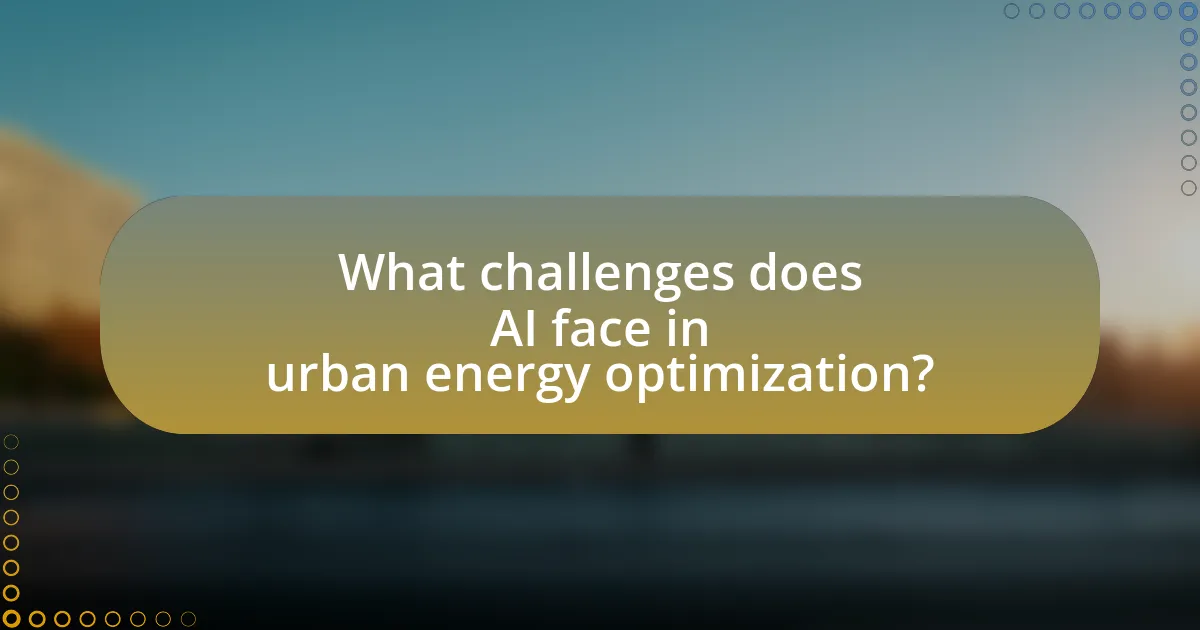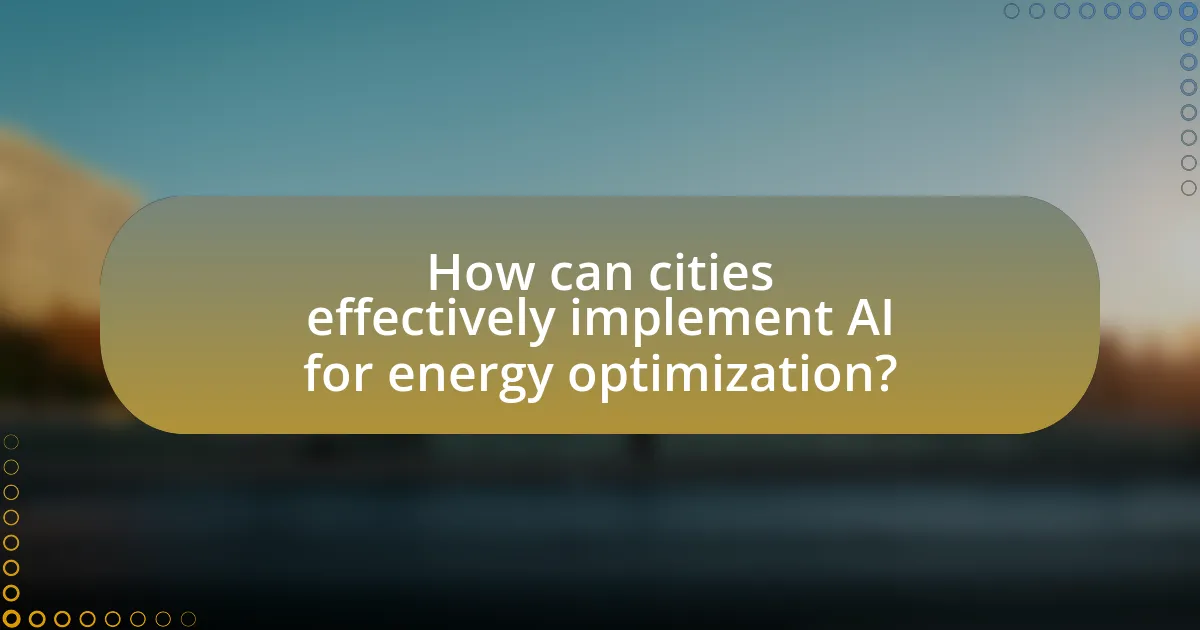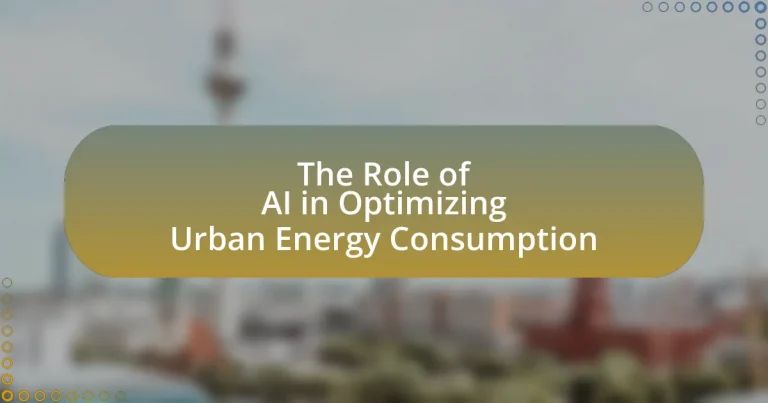The article focuses on the role of artificial intelligence (AI) in optimizing urban energy consumption. It highlights how AI enhances energy efficiency through predictive analytics, real-time monitoring, and machine learning algorithms, leading to significant reductions in energy use and costs. Key technologies such as smart grids and IoT devices are discussed, along with the benefits of AI in reducing greenhouse gas emissions and improving decision-making in energy management. The article also addresses challenges such as data integration, privacy concerns, and biases in AI algorithms, while providing strategies for effective implementation and continuous improvement in urban energy systems.

What is the Role of AI in Optimizing Urban Energy Consumption?
AI plays a crucial role in optimizing urban energy consumption by analyzing vast amounts of data to enhance efficiency and reduce waste. Through machine learning algorithms, AI can predict energy demand patterns, enabling cities to adjust supply accordingly, which leads to significant cost savings and lower carbon emissions. For instance, a study by the International Energy Agency found that AI applications in energy management could reduce energy consumption in buildings by up to 20%. Additionally, AI-driven smart grids facilitate real-time monitoring and control of energy distribution, further optimizing resource allocation and minimizing outages.
How does AI contribute to energy efficiency in urban settings?
AI contributes to energy efficiency in urban settings by optimizing energy consumption through predictive analytics and real-time monitoring. For instance, AI algorithms analyze data from smart meters and sensors to forecast energy demand, enabling utilities to adjust supply accordingly and reduce waste. A study by the International Energy Agency found that AI applications in energy management can lead to a 10-20% reduction in energy use in buildings. Additionally, AI-driven systems can enhance the efficiency of public transportation by optimizing routes and schedules, further decreasing overall energy consumption in urban areas.
What technologies enable AI to optimize energy consumption?
AI optimizes energy consumption through technologies such as machine learning, predictive analytics, and Internet of Things (IoT) devices. Machine learning algorithms analyze vast datasets to identify patterns in energy usage, enabling more efficient energy management. Predictive analytics forecast energy demand and supply, allowing for better resource allocation. IoT devices collect real-time data from various sources, facilitating immediate adjustments to energy systems. For instance, a study by the International Energy Agency found that AI applications in energy management can reduce energy consumption by up to 10-20% in urban settings, demonstrating the effectiveness of these technologies in optimizing energy use.
How does AI analyze energy usage patterns in cities?
AI analyzes energy usage patterns in cities by employing machine learning algorithms to process large datasets from smart meters, sensors, and historical consumption records. These algorithms identify trends, anomalies, and correlations in energy consumption, enabling predictive modeling of future usage. For instance, a study by the International Energy Agency found that AI can improve energy efficiency by up to 20% through optimized demand forecasting and real-time monitoring. By leveraging these insights, city planners can implement targeted energy-saving measures and enhance grid management, ultimately leading to reduced energy waste and lower costs.
What are the key benefits of using AI for urban energy management?
The key benefits of using AI for urban energy management include enhanced efficiency, predictive analytics, and improved decision-making. AI algorithms analyze vast amounts of data from energy consumption patterns, enabling cities to optimize energy distribution and reduce waste. For instance, a study by the International Energy Agency found that AI can improve energy efficiency in buildings by up to 30% through real-time monitoring and adjustments. Additionally, AI facilitates predictive maintenance, allowing for timely interventions that prevent energy losses, thereby contributing to sustainability goals.
How does AI reduce energy costs for municipalities?
AI reduces energy costs for municipalities by optimizing energy consumption through predictive analytics and real-time monitoring. By analyzing data from various sources, such as weather patterns and energy usage trends, AI systems can forecast energy demand more accurately, allowing municipalities to adjust their energy supply accordingly. For instance, a study by the International Energy Agency found that AI applications in energy management can lead to a reduction in energy costs by up to 20% through improved efficiency and demand response strategies. Additionally, AI can identify inefficiencies in energy distribution and consumption, enabling municipalities to implement targeted interventions that further lower costs.
What environmental impacts can AI-driven energy optimization achieve?
AI-driven energy optimization can significantly reduce greenhouse gas emissions and enhance energy efficiency in urban environments. By analyzing consumption patterns and predicting energy demand, AI systems can optimize energy distribution, leading to a decrease in reliance on fossil fuels. For instance, a study by the International Energy Agency found that AI applications in energy management could reduce global CO2 emissions by up to 4 gigatons annually by 2030. Additionally, AI can facilitate the integration of renewable energy sources, further minimizing environmental impacts and promoting sustainable urban development.

What challenges does AI face in urban energy optimization?
AI faces several challenges in urban energy optimization, primarily including data integration, scalability, and real-time processing. Data integration is difficult due to the diverse sources of energy data, such as smart meters, sensors, and weather forecasts, which often use different formats and standards. Scalability issues arise as AI models must adapt to the increasing complexity and size of urban energy systems, which can involve millions of data points. Real-time processing is essential for effective energy management, yet it requires significant computational resources and advanced algorithms to analyze data quickly and accurately. These challenges hinder the effective deployment of AI solutions in optimizing urban energy consumption.
How do data privacy concerns affect AI implementation?
Data privacy concerns significantly hinder AI implementation by creating barriers to data access and usage. Organizations often face stringent regulations, such as the General Data Protection Regulation (GDPR), which mandates strict guidelines on personal data handling. These regulations compel companies to limit the data they collect and use, thereby restricting the datasets available for training AI models. For instance, a study by the International Data Corporation (IDC) found that 60% of organizations cite data privacy regulations as a primary obstacle to AI adoption. Consequently, the limitations imposed by privacy concerns can lead to less effective AI systems, as they may lack the comprehensive data necessary for accurate predictions and optimizations in urban energy consumption.
What measures can be taken to ensure data security in AI systems?
To ensure data security in AI systems, implementing robust encryption methods is essential. Encryption protects sensitive data by converting it into a format that can only be read by authorized users, thereby preventing unauthorized access. Additionally, regular security audits and vulnerability assessments help identify and mitigate potential risks in the AI infrastructure. According to a 2021 report by the International Data Corporation, organizations that adopt comprehensive security measures, including encryption and regular audits, can reduce the risk of data breaches by up to 60%. Furthermore, employing access controls and authentication mechanisms ensures that only authorized personnel can access sensitive data, further enhancing security.
How does the quality of data influence AI performance in energy optimization?
The quality of data significantly influences AI performance in energy optimization by determining the accuracy and reliability of the models used. High-quality data, characterized by completeness, consistency, and relevance, enables AI algorithms to make precise predictions and optimize energy consumption effectively. For instance, a study by Zhang et al. (2020) in the journal “Energy” demonstrated that using high-resolution data improved the predictive accuracy of energy consumption models by over 30%. Conversely, poor-quality data can lead to erroneous conclusions and inefficient energy management strategies, ultimately undermining the potential benefits of AI in urban energy optimization.
What are the limitations of current AI technologies in this field?
Current AI technologies in optimizing urban energy consumption face several limitations, including data quality issues, lack of interoperability, and scalability challenges. Data quality is often compromised due to incomplete or inaccurate datasets, which can lead to suboptimal decision-making. Additionally, many AI systems struggle with interoperability, as they may not effectively communicate with existing infrastructure or other technologies, hindering their integration into urban energy systems. Scalability is another significant limitation; AI models that work well in small-scale pilot projects may not perform effectively when applied to larger, more complex urban environments. These limitations are supported by studies indicating that data-driven models often require extensive tuning and validation to ensure reliability in real-world applications.
How does the complexity of urban energy systems challenge AI solutions?
The complexity of urban energy systems challenges AI solutions primarily due to the intricate interdependencies among various components, such as generation, distribution, and consumption. These systems involve numerous stakeholders, including utility companies, consumers, and regulatory bodies, each with distinct objectives and data requirements. The variability in energy sources, such as renewable and non-renewable, adds layers of unpredictability, making it difficult for AI algorithms to accurately model and predict energy flows. Additionally, the integration of smart technologies and IoT devices generates vast amounts of data, which can overwhelm AI systems if not managed effectively. Research indicates that the dynamic nature of urban energy consumption patterns, influenced by factors like weather, time of day, and socio-economic conditions, further complicates the development of robust AI solutions.
What are the potential biases in AI algorithms affecting energy management?
Potential biases in AI algorithms affecting energy management include data bias, algorithmic bias, and user bias. Data bias occurs when the training data used to develop AI models is not representative of the entire population, leading to skewed predictions and decisions. For instance, if historical energy consumption data predominantly reflects affluent neighborhoods, the AI may underperform in predicting energy needs in lower-income areas. Algorithmic bias arises from the design of the algorithms themselves, which may prioritize certain variables over others, potentially neglecting critical factors like local climate variations or demographic differences. User bias can manifest when human operators influence AI outcomes based on their own assumptions or preferences, further skewing results. Research by the AI Now Institute highlights that these biases can lead to inequitable energy distribution and inefficient resource allocation, ultimately undermining the effectiveness of AI in optimizing urban energy consumption.

How can cities effectively implement AI for energy optimization?
Cities can effectively implement AI for energy optimization by integrating smart grid technologies, utilizing predictive analytics, and deploying machine learning algorithms to analyze energy consumption patterns. Smart grids enable real-time monitoring and management of energy resources, allowing cities to optimize energy distribution and reduce waste. Predictive analytics can forecast energy demand based on historical data, weather patterns, and occupancy rates, leading to more efficient energy usage. Machine learning algorithms can identify inefficiencies and suggest improvements in energy systems, which has been shown to reduce energy consumption by up to 20% in various urban settings. For instance, a study by the International Energy Agency found that AI applications in energy management can lead to significant cost savings and emissions reductions, validating the effectiveness of these technologies in urban environments.
What strategies should urban planners adopt for AI integration?
Urban planners should adopt strategies that include data-driven decision-making, stakeholder engagement, and iterative testing for AI integration. Data-driven decision-making involves utilizing AI algorithms to analyze energy consumption patterns, which can lead to more efficient urban designs. Stakeholder engagement ensures that the needs and concerns of the community are addressed, fostering acceptance and collaboration in AI initiatives. Iterative testing allows planners to refine AI applications based on real-world feedback, enhancing their effectiveness in optimizing energy consumption. These strategies are supported by case studies showing that cities employing AI for energy management have achieved up to 20% reductions in energy use, demonstrating the tangible benefits of such integration.
How can collaboration between stakeholders enhance AI deployment?
Collaboration between stakeholders enhances AI deployment by facilitating resource sharing, aligning objectives, and fostering innovation. When government agencies, private companies, and community organizations work together, they can pool data, expertise, and funding, which accelerates the development and implementation of AI solutions. For instance, a study by the International Energy Agency highlights that collaborative efforts in urban energy management can lead to a 20% reduction in energy consumption through optimized AI applications. This synergy not only improves the effectiveness of AI systems but also ensures that the solutions are tailored to meet the specific needs of urban environments, ultimately driving more sustainable energy practices.
What role do pilot projects play in testing AI solutions?
Pilot projects serve as essential tools for testing AI solutions by providing a controlled environment to evaluate their effectiveness and feasibility. These projects allow organizations to implement AI technologies on a smaller scale, enabling them to assess performance metrics, identify potential challenges, and gather user feedback before full-scale deployment. For instance, a pilot project in urban energy consumption might involve deploying an AI-driven energy management system in a limited area to monitor energy usage patterns and optimize resource allocation. This approach not only minimizes risks associated with large-scale implementation but also facilitates iterative improvements based on real-world data, thereby enhancing the overall reliability of AI solutions in optimizing urban energy consumption.
What best practices should be followed for successful AI implementation?
Successful AI implementation requires a clear strategy, robust data management, and continuous evaluation. Establishing a well-defined strategy aligns AI initiatives with organizational goals, ensuring that the technology addresses specific challenges in urban energy consumption. Effective data management involves collecting high-quality, relevant data, as AI systems rely on accurate information to generate insights. Continuous evaluation and iteration of AI models are essential to adapt to changing conditions and improve performance over time. According to a McKinsey report, organizations that prioritize these best practices see a 20-30% increase in AI project success rates.
How can cities ensure continuous improvement in AI systems?
Cities can ensure continuous improvement in AI systems by implementing regular data updates, fostering collaboration among stakeholders, and investing in ongoing training for AI models. Regular data updates allow AI systems to adapt to changing urban dynamics, ensuring accuracy and relevance in energy consumption optimization. Collaboration among city planners, energy providers, and technology developers facilitates the sharing of insights and best practices, enhancing the effectiveness of AI applications. Additionally, investing in ongoing training for AI models helps them learn from new data and user feedback, which is crucial for refining algorithms and improving performance over time. These strategies collectively contribute to the sustained advancement of AI systems in urban energy management.
What metrics should be used to evaluate AI effectiveness in energy consumption?
To evaluate AI effectiveness in energy consumption, key metrics include energy savings, carbon footprint reduction, operational efficiency, and predictive accuracy. Energy savings quantify the reduction in energy usage achieved through AI interventions, while carbon footprint reduction measures the decrease in greenhouse gas emissions resulting from optimized energy consumption. Operational efficiency assesses improvements in system performance and resource utilization, and predictive accuracy evaluates how well AI forecasts energy demand and consumption patterns. These metrics provide a comprehensive framework for assessing the impact of AI on urban energy optimization, supported by studies showing that AI can lead to energy savings of up to 30% in smart grid applications.
What are practical tips for cities looking to adopt AI in energy management?
Cities looking to adopt AI in energy management should start by conducting a comprehensive energy audit to identify consumption patterns and inefficiencies. This foundational step enables cities to understand their energy landscape and prioritize areas for AI intervention. Following the audit, cities should invest in smart meters and IoT devices to collect real-time data, which is essential for AI algorithms to analyze and optimize energy usage effectively.
Additionally, forming partnerships with technology providers and academic institutions can facilitate access to expertise and innovative solutions tailored to local needs. Implementing pilot projects allows cities to test AI applications on a smaller scale before full deployment, minimizing risks and ensuring scalability.
Moreover, cities should focus on developing a robust data governance framework to ensure data quality, security, and privacy, which are critical for successful AI integration. Training city staff on AI technologies and their applications in energy management will enhance operational capabilities and foster a culture of innovation.
These strategies are supported by case studies, such as Barcelona’s smart lighting system, which reduced energy consumption by 30% through AI-driven optimization, demonstrating the tangible benefits of AI in urban energy management.


